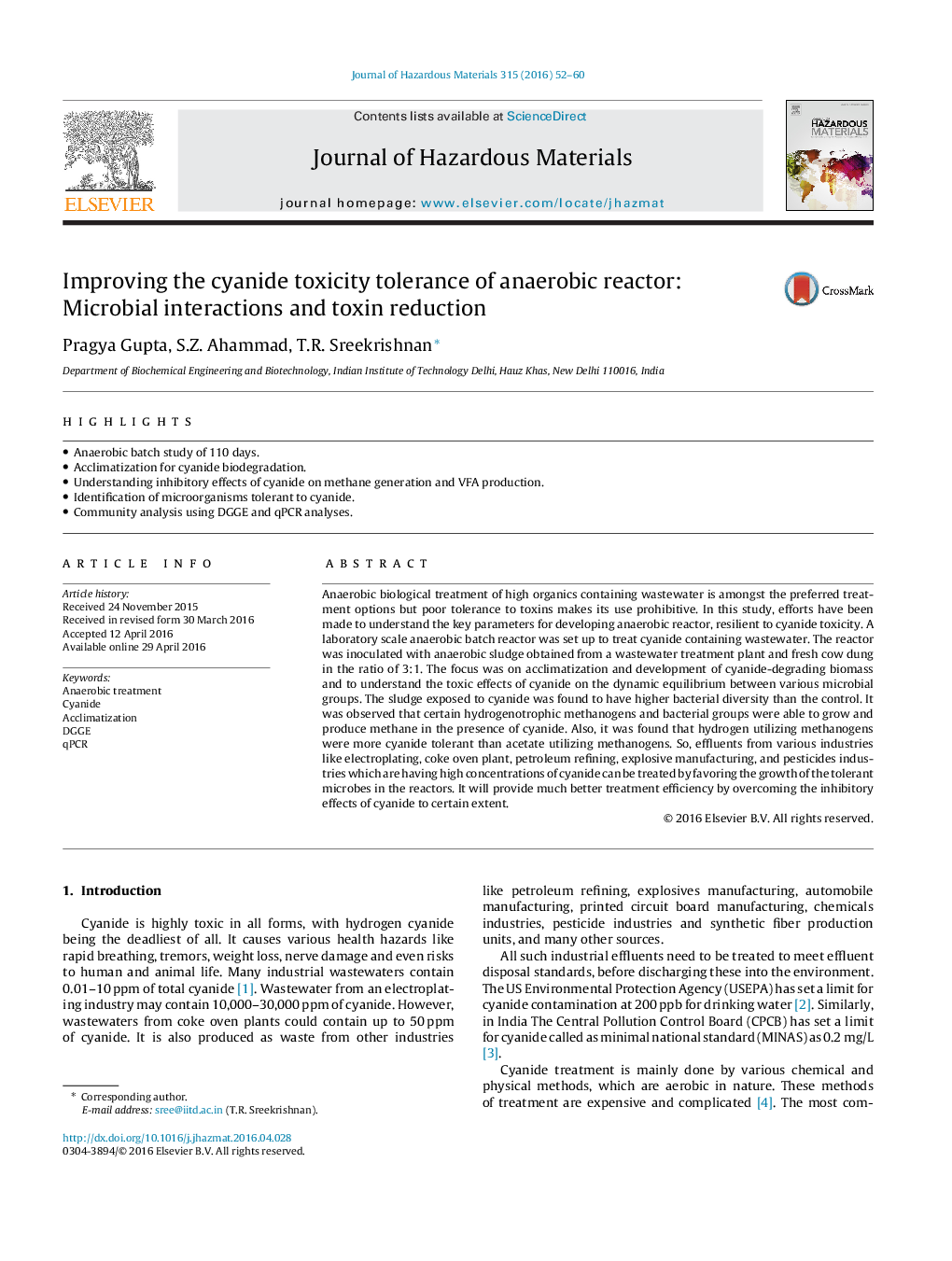| کد مقاله | کد نشریه | سال انتشار | مقاله انگلیسی | نسخه تمام متن |
|---|---|---|---|---|
| 575229 | 1453045 | 2016 | 9 صفحه PDF | دانلود رایگان |
عنوان انگلیسی مقاله ISI
Improving the cyanide toxicity tolerance of anaerobic reactor: Microbial interactions and toxin reduction
ترجمه فارسی عنوان
بهبود تحمل سمی نسبت به ساییدگی راکتور بی هوازی: تعاملات میکروبی و کاهش سم زدایی
دانلود مقاله + سفارش ترجمه
دانلود مقاله ISI انگلیسی
رایگان برای ایرانیان
کلمات کلیدی
ترجمه چکیده
درمان بی هوازی بیولوژیکی آلی با مواد حاوی فاضلاب در میان گزینه های ترجیحی درمان است، اما تحمل ضعیف در برابر سموم باعث می شود که استفاده از آن بسیار زیاد باشد. در این مطالعه، تلاش شده است تا به درک پارامترهای کلیدی برای توسعه راکتور بی هوازی، مقاوم در برابر سمیت سیانید تبدیل شود. برای مقابله با فاضلاب حاوی سیانید، یک آزمایشگاه آزمایشگاهی برای تهیه فاضلاب تهیه شد. این راکتور با لجن بیهوازی که از یک ایستگاه تصفیه فاضلاب و گندم تازه در نسبت 3: 1 به دست می آید، تلقی می شود. تمرکز بر انطباق و توسعه زیست توده زیست محیطی سایان و درک اثرات سمی سیانید بر تعادل دینامیکی بین گروه های مختلف میکروبی بود. لجن موجود در معرض سیانید دارای تنوع بیشتر باکتری نسبت به کنترل است. مشخص شد که برخی متانوژن های هیدروژنوتروپیک و گروه های باکتری قادر به رشد و تولید متان در حضور سیانید هستند. همچنین مشخص شد که هیدروژن با استفاده از متانوژنها بیشتر از سیانید قابل تحمل استات با استفاده از متانوژنها است. بنابراین، پساب از صنایع مختلف مانند آبکاری، کوره کک، پالایش نفت، تولید مواد منفجره و صنایع آفت کش که دارای غلظت بالایی از سیانید هستند، می توانند با افزایش رشد میکروب های تحمل کننده در راکتورها درمان شوند. این کار با رفع اثرات مهاری سیانید به میزان معینی باعث بهبود کارایی درمان خواهد شد.
موضوعات مرتبط
مهندسی و علوم پایه
مهندسی شیمی
بهداشت و امنیت شیمی
چکیده انگلیسی
Anaerobic biological treatment of high organics containing wastewater is amongst the preferred treatment options but poor tolerance to toxins makes its use prohibitive. In this study, efforts have been made to understand the key parameters for developing anaerobic reactor, resilient to cyanide toxicity. A laboratory scale anaerobic batch reactor was set up to treat cyanide containing wastewater. The reactor was inoculated with anaerobic sludge obtained from a wastewater treatment plant and fresh cow dung in the ratio of 3:1. The focus was on acclimatization and development of cyanide-degrading biomass and to understand the toxic effects of cyanide on the dynamic equilibrium between various microbial groups. The sludge exposed to cyanide was found to have higher bacterial diversity than the control. It was observed that certain hydrogenotrophic methanogens and bacterial groups were able to grow and produce methane in the presence of cyanide. Also, it was found that hydrogen utilizing methanogens were more cyanide tolerant than acetate utilizing methanogens. So, effluents from various industries like electroplating, coke oven plant, petroleum refining, explosive manufacturing, and pesticides industries which are having high concentrations of cyanide can be treated by favoring the growth of the tolerant microbes in the reactors. It will provide much better treatment efficiency by overcoming the inhibitory effects of cyanide to certain extent.
ناشر
Database: Elsevier - ScienceDirect (ساینس دایرکت)
Journal: Journal of Hazardous Materials - Volume 315, 5 September 2016, Pages 52-60
Journal: Journal of Hazardous Materials - Volume 315, 5 September 2016, Pages 52-60
نویسندگان
Pragya Gupta, S.Z. Ahammad, T.R. Sreekrishnan,
